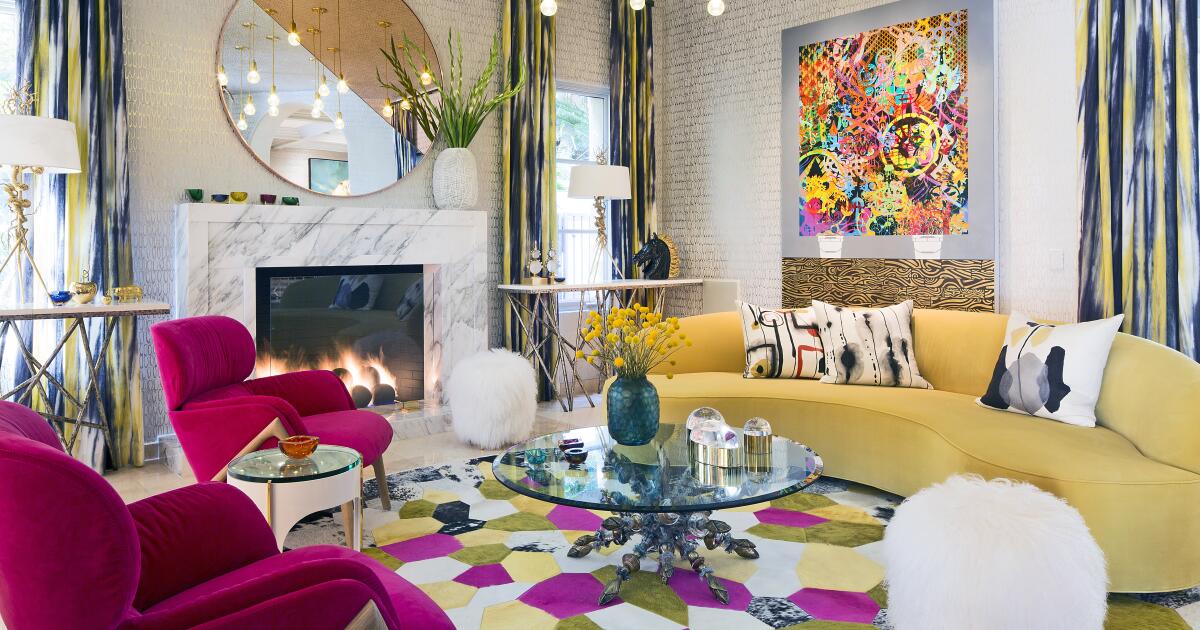Over the past few years, the forecast has been cloudy when it comes to couches. Cumulus-like sofas have descended from the skies into living rooms across Los Angeles and the country at large.
To some, like Annie Elliott of Annie Elliott Design, sinuous sofas are often an unwelcome, alien presence. “I just don’t like them,” she says, describing many as “massive, space-age blobs” in white boucle that don’t fit most spaces. “I’m manifesting that they’ll be out of style in 15 minutes.”
But many, like Los Angeles designer Jeff Andrews of Jeff Andrews Design, feel differently. Andrews designed two curvy couches for his collection with furniture company A. Rudin and estimates he includes a serpentine sofa in roughly half his design projects.
“There’s always an opportunity for a curved sofa,” he says, “whether the setting is traditional or ultra-modern.” Circular and S-shaped couches might seem newfangled, but they’re classic, he adds.
Initially popular during the Art Deco era, this type of seating was back in fashion in the 1950s (when designer Vladimir Kagan introduced his Serpentine Sofa). Now that Midcentury Modern is wildly popular again, it’s no wonder the curved couch has made a comeback. But if you’re still on the fence about getting one, consider these reasons and picks.
Where to place a curvy couch
Place a serpentine sofa in the middle of a room and you’ll instantly transform it from wan white box to theater-worthy. A curvy couch is outside of the box, literally, and can help achieve a more custom, interesting look, says Andrews.
One reason for these couches’ star power? Their curves contrast with the angularity of most spaces and depart from the conventional rectilinear profile of sofas. Curvy couches can soften all those 90-degree angles and add femininity, says Los Angeles-based Kim Gordon of Kim Gordon Designs. She describes including them as akin to “bringing in some girly hips.”
A curvy couch adds interest to this room designed by Kim Gordon.
(Tyler Hogan )
But their benefits are more than aesthetic. Curvy couches can also be practical, especially in open-plan spaces. Large rooms can feel cold and cavernous. But a large-scale serpentine sofa in the center can break up a space, acting as both seating and separation. Including one or two of these couches is an alternative to creating two or three distinct seating areas with several pieces of furniture, says Gordon. Because of their curves, the couches create a space within a space, adds Atlanta-based Jessica Davis of Atelier Davis, who describes them as hug-like and enveloping. Even if you’re sitting at the opposite end from someone else, you can still have a conversation with them, she says.
While these sofas are often found in large spaces, they can work in small ones too. A single couch can take the place of a sectional or a sofa and a chair or two, Gordon says. In a cozy room, one curvy couch with a coffee table and side tables might be all the furniture you need.
Since they’re not rectangular, you can also be creative and play around with their positioning, adds Andrews. Unlike a traditional couch, a curvy couch doesn’t need to be pushed against a wall — in fact, it shouldn’t be. Tuck it into a corner or float it in the center of a room, he says. “You can angle it different ways for different feelings, depending on where you’re trying to center the attention.”
How to pick the right couch
Curvy couches are often deeper than their traditional counterparts, says Beth Diana Smith of Beth Diana Smith Interior Design. So before you fall for the wrong one, whip out the measuring tape. Measure each contender or confirm its specs with the manufacturer, suggests Davis. Pay attention to overall depth versus seat depth — different manufacturers can specify depth differently. Then use painter’s tape to outline the silhouette on your floor, ensuring the couch will fit.
Also consider how highly you value comfort. Some curvy couches, especially more sculptural models, might not be deep enough for you to curl up in, says Julia DeMarco of Kim Gordon Designs. Test each one and seek out down- or feather-filled cushions, which will “give” when you sit, DeMarco adds.
If you’re not a fan of the couch’s material (many come in “gray, icky” stock fabrics, says Gordon), you can always reupholster.
Finally, don’t pair your curved couch with similarly curvy tables and chairs, says Smith, since “too much of the same thing isn’t visually pleasing.” In fact, it can feel almost … square.
Curvy couches that inspire
Consider these couches across the price spectrum, some of which have changing prices due to sales.
Jacqueline 89.4-inch Upholstered Sofa ($1,399): This couch with a curved back and gold legs feels glam and feminine. In the Kelly Clarkson Collection available from Wayfair, it features a deep seat and comes in five fabrics (including light blue and pink).
Brayden Studio® 125-inch Modern Curved Sectional Sofa ($2,839): DeMarco sometimes incorporates this sectional from Wayfair in homes she stages.
Crate & Barrel Martina 94-inch Sofa ($2,159): Here’s a subtle take, featuring a kidney-shaped, 43-inch-deep bench seat and pillows with feather-down fill. The base is solid walnut, and the off-white upholstery is a linen blend.
Eternity Modern Savelle Modern Curved Sofa ($3,659-$5,779): Designed by Swedish architect Jonas Wagell, this couch comes in six boucle or sheepskin fabric choices, all in neutral hues. With a medium-firm, customizable cushion and a seat depth of 23 inches, it’s “comfy” and “our go-to,” says DeMarco.
Edra Standard Francesco Binfaré (price upon request): “If you want to go ‘bananas,’ this one is orgasmic,” Gordon says. “It’s just heaven.” The deep, customizable couch features backrests and armrests you can mold with just a touch of your hand. It’s sold at Spazio Edra Los Angeles by Diva Furniture in West Hollywood.






